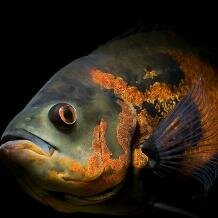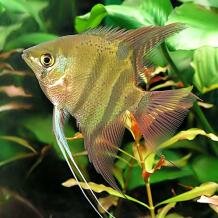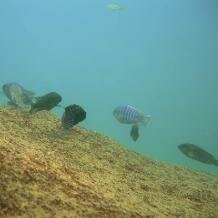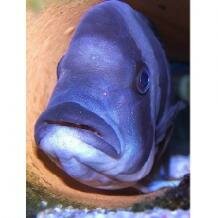Topic: Cichlids
Cichlids are one of the cause celebré of evolution, and rightly so because these freshwater fish show a remarkable diversity and exemplify many key aspects of adaptive radiation. But why so successful? The answer lies in the versatility of the jaws (and yes, they are convergent).
 Cichlids are one of the cause celebré of evolution, and rightly so because these freshwater fish, which are most species-rich in the lakes (and rivers) of Africa and South America, show a remarkable diversity and exemplify many key aspects of adaptive radiation. The most striking aspect of these radiations is the formation of species flocks, diverse groups of species that are closely related and occur in an isolated area. These do not only reflect extensive and rapid speciation, but also associated features such as sexual selection, trophic specialisations and complex behaviour. Whilst cichlid fish are exemplars of divergence, they also show many striking instances of convergence.
Cichlids are one of the cause celebré of evolution, and rightly so because these freshwater fish, which are most species-rich in the lakes (and rivers) of Africa and South America, show a remarkable diversity and exemplify many key aspects of adaptive radiation. The most striking aspect of these radiations is the formation of species flocks, diverse groups of species that are closely related and occur in an isolated area. These do not only reflect extensive and rapid speciation, but also associated features such as sexual selection, trophic specialisations and complex behaviour. Whilst cichlid fish are exemplars of divergence, they also show many striking instances of convergence.
Pharyngeal jaws and feeding
 Perhaps the most important is a complex arrangement of the pharyngeal jaws (a second set of jaws in the pharynx that are functionally separate from the oral teeth), including specific arrangements of muscles and articulation. This evidently allows an extraordinary potential for various types of feeding and has been widely assumed to underpin cichlid success (although the evidence is not conclusive). The complex pharyngeal jaw arrangement of the cichlids is strikingly similar to that of the marine labrid fish and had long been assumed to have a common origin, but it is now known to be convergent.
Perhaps the most important is a complex arrangement of the pharyngeal jaws (a second set of jaws in the pharynx that are functionally separate from the oral teeth), including specific arrangements of muscles and articulation. This evidently allows an extraordinary potential for various types of feeding and has been widely assumed to underpin cichlid success (although the evidence is not conclusive). The complex pharyngeal jaw arrangement of the cichlids is strikingly similar to that of the marine labrid fish and had long been assumed to have a common origin, but it is now known to be convergent.
 Pharyngeal jaws can be modified as crushing tooth plates to eat hard-bodied prey (durophagy). While in the Neotropical heroine cichlids the ability to crush molluscs may have arisen several times, durophagy has independently evolved many times in other bony fish (e.g. Haemulidae, Tetraodontiformes) as well as in the cartilaginous fish (e.g. in eagle rays and horn sharks).
Pharyngeal jaws can be modified as crushing tooth plates to eat hard-bodied prey (durophagy). While in the Neotropical heroine cichlids the ability to crush molluscs may have arisen several times, durophagy has independently evolved many times in other bony fish (e.g. Haemulidae, Tetraodontiformes) as well as in the cartilaginous fish (e.g. in eagle rays and horn sharks).
There are also important convergences in terms of plankton feeding between South American and African cichlids (e.g. pearl cichlid Geophagus brasiliensis and Congo tilapia Tilapia rendalli). These include similar changes between when they feed as young as against adults, initially picking off larger prey one-by-one and then sucking smaller prey in large numbers. Such a shift in feeding mode might serve to optimally exploit patchily distributed plankton resources and it is also observed in other planktivorous fish, suggesting the evolution of only a few stereotyped feeding behaviours in microphagous fish.
Ecomorphs
 The great lakes along the African rift, notably Malawi and Tanganyika, house a remarkable array of cichlids (about 1,500 documented, of an estimated total of perhaps 2,000 to 2,500 species) and show many examples of ecomorphological convergence. In effect, these occur at two levels, convergences within a given lake and convergences between the lakes.
The great lakes along the African rift, notably Malawi and Tanganyika, house a remarkable array of cichlids (about 1,500 documented, of an estimated total of perhaps 2,000 to 2,500 species) and show many examples of ecomorphological convergence. In effect, these occur at two levels, convergences within a given lake and convergences between the lakes.
Within Lake Tanganyika, ecomorphological convergences include reproduction and parental care (e.g. mouthbrooding), patterns of facial stripes, colonisation of rocky habitats and trophic specialisations, including those of teeth. Cichlids from Lake Malawi show, for example, parallels in nuptial colouration. Interestingly, in at least Lake Malawi, the stages of divergence (typically leading to convergence) seem to initially involve trophic specialisations and habitat choice (especially sandy bottoms versus rocks), and later in the evolutionary story sexual selection.
 What is arguably more remarkable are the number of striking convergences that are found in the cichlids living in different lakes, again notably those involving Lake Malawi and Lake Tanganyika. These similarities naturally provoke questions, such as given they are all cichlids, should we be surprised at all, and in any event are they not better treated as parallelisms? The Map of Life view is that there is a continuum of convergences from very local to inter-kingdom, and as long as we define our phylogeny then we can treat all as convergences. So too, given the relatively close relationships of these lake faunas, to what extent do the “same genes” produce the “same results”? There is probably some truth in this, but at least some investigators are struck that in both this example and others (where the genotypes are better documented) the convergences are driven by the same adaptive pressures steering the cichlids to similar solutions: give me an adaptive zone and I’ll give you the fish.
What is arguably more remarkable are the number of striking convergences that are found in the cichlids living in different lakes, again notably those involving Lake Malawi and Lake Tanganyika. These similarities naturally provoke questions, such as given they are all cichlids, should we be surprised at all, and in any event are they not better treated as parallelisms? The Map of Life view is that there is a continuum of convergences from very local to inter-kingdom, and as long as we define our phylogeny then we can treat all as convergences. So too, given the relatively close relationships of these lake faunas, to what extent do the “same genes” produce the “same results”? There is probably some truth in this, but at least some investigators are struck that in both this example and others (where the genotypes are better documented) the convergences are driven by the same adaptive pressures steering the cichlids to similar solutions: give me an adaptive zone and I’ll give you the fish.
Fascinating ecomorphological convergences have also been identified in cichlids living in river habitats in the Zambezi, Venezuela and Costa Rica, amongst which some types of feeding stand out.
Parental care
 The case of convergence of mouthbrooding within Lake Tanganyika was mentioned above, but on a global scale we see even more striking instances. Mouthbrooding, one of the most advanced forms of parental care known in fish, has evolved at least 10 times in different families of fish, such as in cardinalfish (Apogonidae), marine catfish (Ariidae) and jawfishes (Opistognathidae). Intriguingly, mouthbrooding is also found in the Darwin’s frog (Rhinoderma darwinii), where the male raises the tadpoles inside his vocal sac.
The case of convergence of mouthbrooding within Lake Tanganyika was mentioned above, but on a global scale we see even more striking instances. Mouthbrooding, one of the most advanced forms of parental care known in fish, has evolved at least 10 times in different families of fish, such as in cardinalfish (Apogonidae), marine catfish (Ariidae) and jawfishes (Opistognathidae). Intriguingly, mouthbrooding is also found in the Darwin’s frog (Rhinoderma darwinii), where the male raises the tadpoles inside his vocal sac.
Fish generally show three types of mouthbrooding: biparental, maternal and paternal. In cichlids, the transition from the probably ancestral biparental mouthbrooding to female-only care has evidently occurred several times independently.
Brain structure
The trophic and behavioural complexities of the cichlids are reflected in their brain structure. For example, one study indicated that species living in complex, spatially structured habitats, such as in rock crevices or amongst reeds, have particularly large forebrains (similar to what has been found in Hawaiian reef fishes). Another study on a group known as the ectodinids in Lake Tanganyika found evidence for a correlation between the mating system and enlargements of various parts of the brain – monogamous species had a larger telencephalon, whereas in polygamous cichlids the hypothalamus was enlarged. This in turn was attributed to such matters as the requirements for spatial learning and courtship. Given polygamy is convergent, so there will be parallel changes in brain structure. Furthermore, the biggest telencephalons appeared to be associated with a specific combination of monogamy and inhabiting a rocky environment, so too suggesting that such a feature is far from accidental. A more recent study, however, which was based on a larger sample and accounted for phylogenetic relationships, found no correlation between habitat complexity and brain size. Instead, brain size was related to diet and parental care type. Species with female-only care were shown to possess larger brains than those with biparental care, suggesting that uniparental care might require greater cognitive abilities. Interestingly, this was due to a difference in female brain size only (similar to carnivores).
Death feigning (Thanatosis)
 Perhaps the most remarkable of cichlid convergences involves a special sort of death feigning (thanatosis) to the extent of appearing to have begun to decay, or alternatively just looking very ill indeed, so that an incautious investigator discovers that the “dead” or “dying” cichlid is actually very much alive and has turned into a predator! This has evolved independently in Lake Malawi (Nimbochromis livingstonii) and in the Yucatán (Parachromis friedrichsthalii). In addition, a marine example of this behaviour has been reported in the Brazilian comb grouper (Mycteroperca acutirostris), although the details of this story remain uncertain.
Perhaps the most remarkable of cichlid convergences involves a special sort of death feigning (thanatosis) to the extent of appearing to have begun to decay, or alternatively just looking very ill indeed, so that an incautious investigator discovers that the “dead” or “dying” cichlid is actually very much alive and has turned into a predator! This has evolved independently in Lake Malawi (Nimbochromis livingstonii) and in the Yucatán (Parachromis friedrichsthalii). In addition, a marine example of this behaviour has been reported in the Brazilian comb grouper (Mycteroperca acutirostris), although the details of this story remain uncertain.
Cite this web page
Map of Life - "Cichlids"
https://mapoflife.org/topics/topic_464_cichlids/
March 3, 2021

